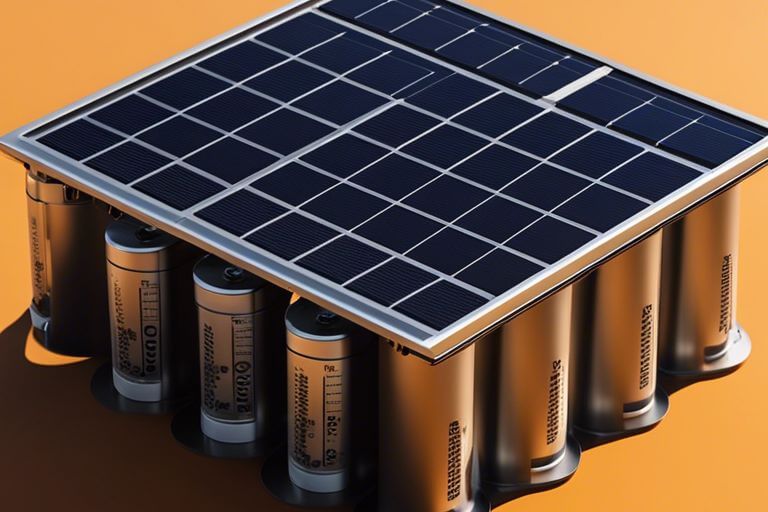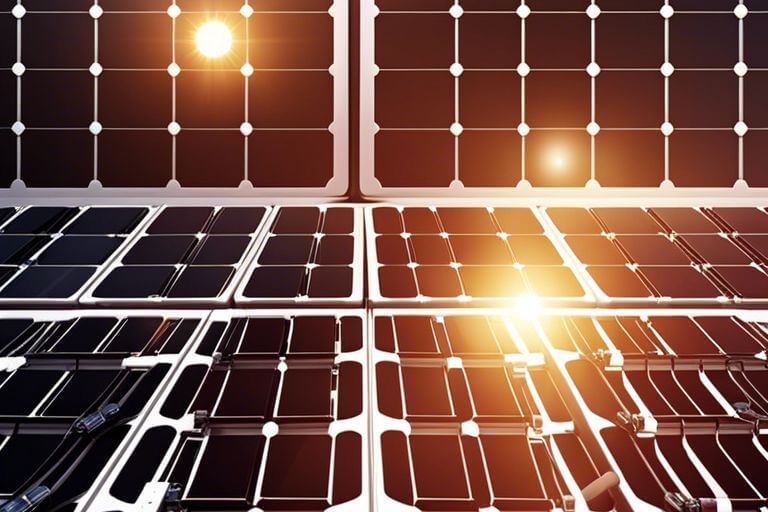You’ve decided to dip your toes into the world of solar energy with a 400-watt solar system, but now you’re scratching your head, wondering how many batteries you actually need to make it work efficiently. Don’t fret, my friend, for I’m here to break it down for you in a way that’s as clear as a pane of freshly cleaned glass. Let’s navigate the electrifying world of solar power together and figure out just how many batteries you’ll need to keep your system running smoothly.
Key Takeaways:
- Calculate your energy needs: Determine the daily watt-hour consumption of your appliances to estimate the number of batteries required for your 400-watt solar system.
- Battery capacity: Choose deep-cycle batteries with enough capacity to store the energy generated by your solar panels, typically measured in amp-hours.
- Consider system efficiency: Account for factors like system inefficiencies, cloudy days, and battery depth of discharge to ensure you have enough batteries to meet your energy requirements.
Determining Your Energy Needs
Calculating Your Daily Energy Consumption
One of the first steps in determining how many batteries you need for your 400-watt solar system is to calculate your daily energy consumption. Start by making a list of all the appliances and devices you use on a daily basis and how many hours you typically use them. This will give you an idea of how much energy you need to power your lifestyle.
Considering Your Appliance Wattage
On top of calculating your daily energy consumption, you also need to consider the wattage of each appliance you use. Different appliances have different power requirements, so it’s important to take this into account when planning your solar system. Some appliances, like refrigerators or air conditioners, may have higher wattage and will require more energy to operate.
Energy-efficient appliances can help you reduce your overall energy consumption and the number of batteries you need for your solar system. When shopping for new appliances, look for models that have an Energy Star rating, as these are designed to be more energy-efficient and can help you save on your electricity bills in the long run.
Sizing Your Solar System
The Importance of Correct Sizing
If you’re considering setting up a 400-watt solar system, getting the sizing right is crucial. Solar panels need to generate enough power to meet your energy needs, but having too many can lead to unnecessary costs. On the other hand, having too few panels may result in an undersupply of power, leaving you in the dark when you need electricity the most. That’s why it’s necessary to find the perfect balance for your solar system.
How to Calculate Your Solar System Size
To determine the right size for your solar system, you need to consider factors such as your average daily energy consumption, the amount of sunlight your location receives, and the efficiency of the solar panels you plan to use. By calculating these variables, you can estimate the number of panels and batteries you’ll need to power your 400-watt system effectively. Keep in mind, it’s not just about the size of your system, but also about optimizing it to harness as much solar energy as possible.
When calculating your solar system size, consider factors like shading, panel orientation, and weather patterns in your area to maximize energy production. It’s not just about how many panels or batteries you have but also how efficiently you can utilize the sun’s energy to meet your power needs.You may also want to consult with a solar energy expert to ensure that your system is tailored to your specific requirements and location. This way, you can be confident that your 400-watt solar system is optimized for performance and cost-effectiveness.
Battery Capacity and Type
Now let’s talk about the important topic of battery capacity and type for your 400-watt solar system. Choosing the right batteries is crucial to maximize the efficiency and performance of your solar setup.
Deep Cycle Batteries: The Best Choice for Solar Systems
Deep cycle batteries are specifically designed for solar systems because they can withstand deep discharges and recharging cycles better than other types of batteries. These batteries are ideal for storing the energy generated by your solar panels during the day so that you can use it at night or on cloudy days. With their long lifespan and durability, deep cycle batteries are the best choice to ensure a reliable power supply for your solar system.
AGM vs. Flooded Batteries: Which One to Choose
In the matter of choosing between AGM (Absorbent Glass Mat) and flooded batteries for your solar system, both have their pros and cons. AGM batteries are maintenance-free, sealed, and spill-proof, making them a convenient option for many solar system owners. On the other hand, flooded batteries are usually more affordable but require regular maintenance and proper ventilation due to their gas emissions during charging. Ultimately, the choice between AGM and flooded batteries depends on your specific needs and budget.
Understanding the differences between AGM and flooded batteries can help you make an informed decision based on your preferences and requirements. Whether you prioritize convenience or cost-effectiveness, choosing the right type of battery is necessary for the overall performance and longevity of your solar system.

Calculating Battery Quantity
The Role of Depth of Discharge (DOD) in Battery Calculation
Not all batteries can be drained completely without causing damage. This is where the Depth of Discharge (DOD) comes in. DOD indicates how much of the battery’s capacity is used before it needs to be recharged. For example, if a battery has a 50% DOD, you should only use half of its capacity before recharging it. When calculating the number of batteries needed for your 400-watt solar system, you must take into account the DOD to ensure you have enough storage capacity for your energy needs.
Using a Battery Calculator to Simplify the Process
For an accurate calculation of the number of batteries required for your 400-watt solar system, you can use a battery calculator. These online tools take into account your system’s wattage, the voltage of your batteries, and the DOD to determine the ideal number of batteries needed. They simplify the process and help you avoid underestimating your storage requirements. By inputting these key details, you can quickly figure out how many batteries you need to ensure a reliable power supply from your solar system.
Battery calculators can also help you compare different battery options and configurations to find the most cost-effective and efficient solution for your setup. With just a few clicks, you can optimize the performance of your solar system and ensure that you have enough battery capacity to meet your energy needs, even during cloudy days or low sunlight periods.
Factors Affecting Battery Quantity
After determining the size of your 400-watt solar system, you need to consider several factors that will affect the quantity of batteries you will need to store the generated energy. Here are some key factors to keep in mind:
- System voltage: 12V, 24V, or 48V?
- Temperature and its impact on battery performance
System Voltage: 12V, 24V, or 48V?
On the question of system voltage, you have three main options to choose from: 12V, 24V, or 48V. The voltage of your solar system will determine the number of batteries required, as higher voltage systems typically require fewer batteries. However, higher voltage systems also come with higher equipment costs. You will need to weigh the pros and cons of each voltage option based on your specific energy storage needs and budget constraints.
Any decision you make regarding the system voltage should take into account not only the number of batteries required but also the overall efficiency and cost-effectiveness of the system.
Temperature and Its Impact on Battery Performance
For understanding how temperature affects battery performance, it’s vital to consider that temperature can have a significant impact on the efficiency and lifespan of your batteries. Extreme temperatures, whether hot or cold, can lead to decreased battery performance and capacity. It’s important to choose batteries that are rated for the temperature conditions of your location to ensure optimal performance.
| Temperature Range | Impact on Battery Performance |
| High Temperatures | Decreased battery life and efficiency |
| Low Temperatures | Reduced battery capacity and efficiency |
System voltage, temperature, and other factors play a crucial role in determining the quantity of batteries needed for your 400-watt solar system. Consider these factors carefully to ensure the optimal performance and longevity of your solar energy storage system.

Examples and Scenarios
All 400 Watt Solar enough? forum can be quite helpful when determining how many batteries you need for a 400-watt solar system. Various scenarios and examples shared by the community can give you a clearer picture of what might work best for your situation.
A Small Off-Grid Cabin: How Many Batteries Do You Need?
Scenarios such as a small off-grid cabin can provide valuable insights into battery requirements for a 400-watt solar system. In this case, you might need to consider how many appliances you will be running, for how long, and the energy consumption of each. Typically, for a small cabin, a few deep-cycle batteries might be sufficient to store the energy generated by your solar panels.
A Medium-Sized Home: Calculating Battery Requirements
When considering a medium-sized home, calculating battery requirements for a 400-watt solar system becomes more complex. You need to take into account the energy needs of multiple rooms, various appliances, and the number of occupants in the house. It’s imperative to determine the total watt-hours consumed per day and choose a battery bank that can store enough energy to power your home when the sun isn’t shining.
Batteries are a crucial component of your solar system, as they store the excess energy generated during the day for use at night or during cloudy weather. It’s important to invest in high-quality batteries that can withstand frequent charging and discharging cycles to ensure the longevity and efficiency of your off-grid power system.
Summing up
Taking this into account, when setting up a 400-watt solar system, it’s best to have at least one deep cycle battery to store the energy generated. This will ensure that you have a reliable power source even when the sun is not shining. To explore deeper into the subject of battery size requirements for a 400-watt solar system, you can check out What size of battery do I need for a 400-watt solar system with a 3000-watt inverter? on Quora for more insights and advice.
FAQ
Q: How many batteries do I need for a 400-watt solar system?
A: The number of batteries needed for a 400-watt solar system depends on the storage capacity of the batteries. On average, for a 400-watt solar system, you would need around 2 to 4 deep cycle batteries with a total storage capacity of at least 400 amp-hours to store the energy generated by the system.
Q: What type of batteries should I use for a 400-watt solar system?
A: For a 400-watt solar system, it is recommended to use deep cycle batteries such as lead-acid, lithium-ion, or gel batteries. These batteries are designed to withstand deep discharges and provide consistent power output, making them ideal for storing energy from solar panels.
Q: How can I calculate the battery storage capacity needed for a 400-watt solar system?
A: To calculate the battery storage capacity needed for a 400-watt solar system, you can use the following formula: Amp-hour (Ah) = (Total Watt-hours per day) / (Battery Voltage). For example, if your solar system generates 400 watt-hours per day and you are using a 12-volt battery bank, you would need at least a 33.3 Ah battery to store this energy.
